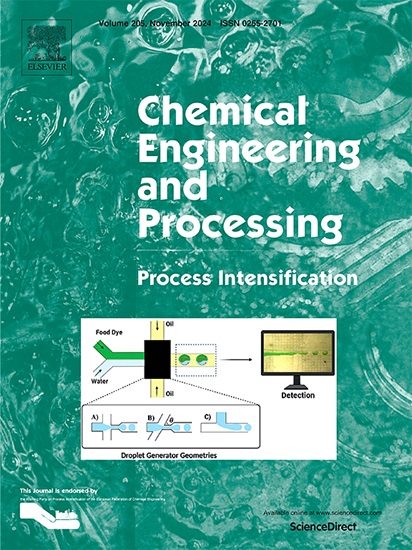Comprehensive numerical and experimental analysis of dynamic gas-liquid separator with various oil-gas ratios
IF 3.8
3区 工程技术
Q3 ENERGY & FUELS
Chemical Engineering and Processing - Process Intensification
Pub Date : 2025-05-08
DOI:10.1016/j.cep.2025.110332
引用次数: 0
Abstract
Dynamic gas-liquid separator is a critical equipment extensively utilized in oil extraction, the nuclear industry, and chemical engineering. The operating parameters, such as flow rate and oil-gas ratio, can vary significantly in real-world applications. To enhance the separator’s performance, this study employs the computational fluid dynamics (CFD)–population balance model (PBM) method to investigate how different oil-gas ratios affect the internal flow field and the overall performance of the dynamic gas-liquid separator. An experimental platform was constructed to test various oil-gas ratios, and the numerical results were compared with experimental data to validate the numerical model's accuracy and reliability. The findings indicate a positive correlation between the oil-gas ratio and both separation performance and energy consumption. As the oil-gas ratio increases, the internal flow field becomes more stable, which is conducive to gas-liquid separation, thereby enhancing the separator's efficiency. However, this also leads to increased energy consumption due to the higher liquid phase volume fraction, necessitating greater power to maintain stable operation. For instance, when the Qo=60 m³‧d-1 and ε increases from 0.5 to 2.5, the degassing rate, power and pressure difference of the separator increase by 20.24 %, 210.03 % and 176.67 %, respectively. Interestingly, while the separator’s degassing rate decreases with a higher flow rate, the deoiling rate improves. The optimal separation efficiency was achieved at a flow rate of 140 m³·d⁻¹, where the degassing and deoiling rates reached 95.21 % and 93.97 %, respectively. As the flow rate continues to rise, the fluid volume per unit time, energy consumption, power requirements, and differential pressure also increase. Based on these findings, prediction equations for separator performance across various oil-gas ratios were developed. These equations offer a valuable theoretical foundation for designing, operating, and optimizing high-performance dynamic separators, contributing to the efficiency and sustainability of industrial applications.

不同油气比动态气液分离器的综合数值与实验分析
动态气液分离器是广泛应用于石油开采、核工业、化工等领域的关键设备。在实际应用中,流量和油气比等操作参数可能会有很大变化。为了提高分离器的性能,本研究采用计算流体力学(CFD) -人口平衡模型(PBM)方法,研究不同油气比对动态气液分离器内部流场和整体性能的影响。搭建了不同油气比的实验平台,并将数值结果与实验数据进行了对比,验证了数值模型的准确性和可靠性。结果表明,油气比与分离性能和能耗均呈正相关。随着油气比的增大,内部流场更加稳定,有利于气液分离,从而提高分离器的效率。然而,由于液相体积分数较高,这也导致能量消耗增加,需要更大的功率来维持稳定的运行。当Qo=60 m³·d-1, ε从0.5增加到2.5时,分离器的脱气率、功率和压差分别提高了20.24%、210.03%和176.67%。有趣的是,尽管分离器的脱气速率随着流量的增加而降低,但脱油速率却提高了。在流速为140 m³·d⁻¹时分离效果最佳,脱气率为95.21%,脱油率为93.97%。随着流量的不断增大,单位时间内的流体体积、能耗、功率要求和压差也随之增大。基于这些发现,建立了不同油气比下分离器性能的预测方程。这些方程为设计、操作和优化高性能动态分离器提供了有价值的理论基础,有助于提高工业应用的效率和可持续性。
本文章由计算机程序翻译,如有差异,请以英文原文为准。
求助全文
约1分钟内获得全文
求助全文
来源期刊
CiteScore
7.80
自引率
9.30%
发文量
408
审稿时长
49 days
期刊介绍:
Chemical Engineering and Processing: Process Intensification is intended for practicing researchers in industry and academia, working in the field of Process Engineering and related to the subject of Process Intensification.Articles published in the Journal demonstrate how novel discoveries, developments and theories in the field of Process Engineering and in particular Process Intensification may be used for analysis and design of innovative equipment and processing methods with substantially improved sustainability, efficiency and environmental performance.

 求助内容:
求助内容: 应助结果提醒方式:
应助结果提醒方式:


